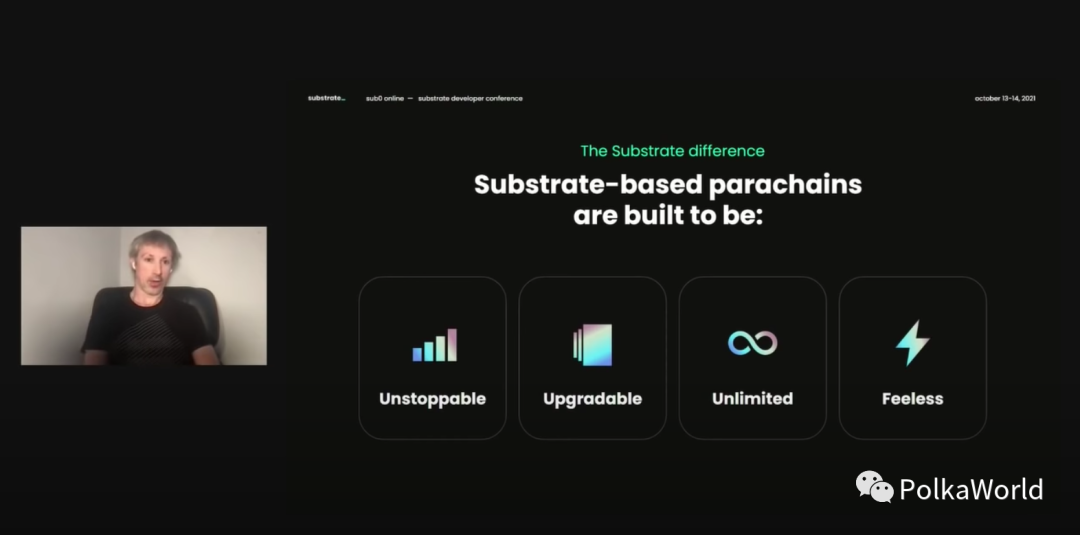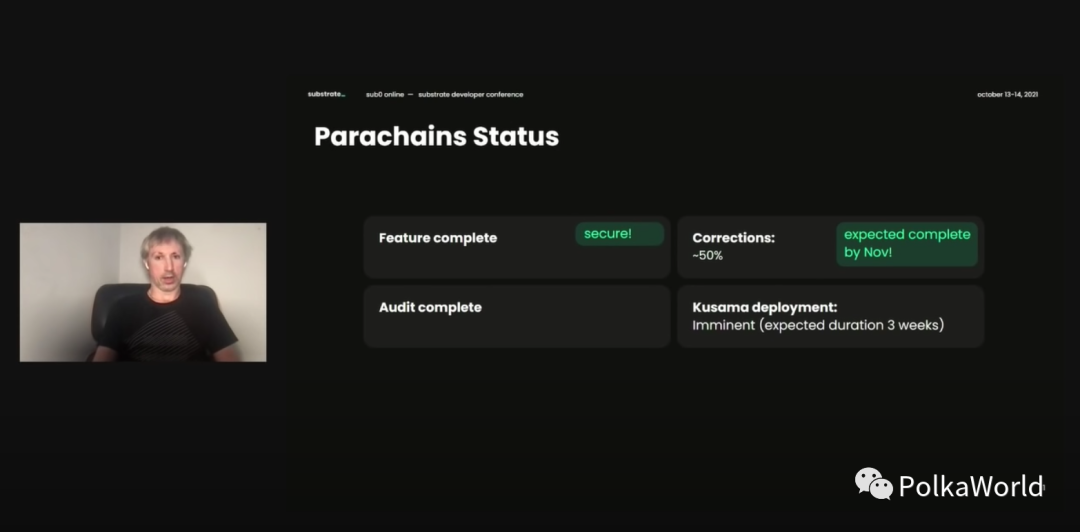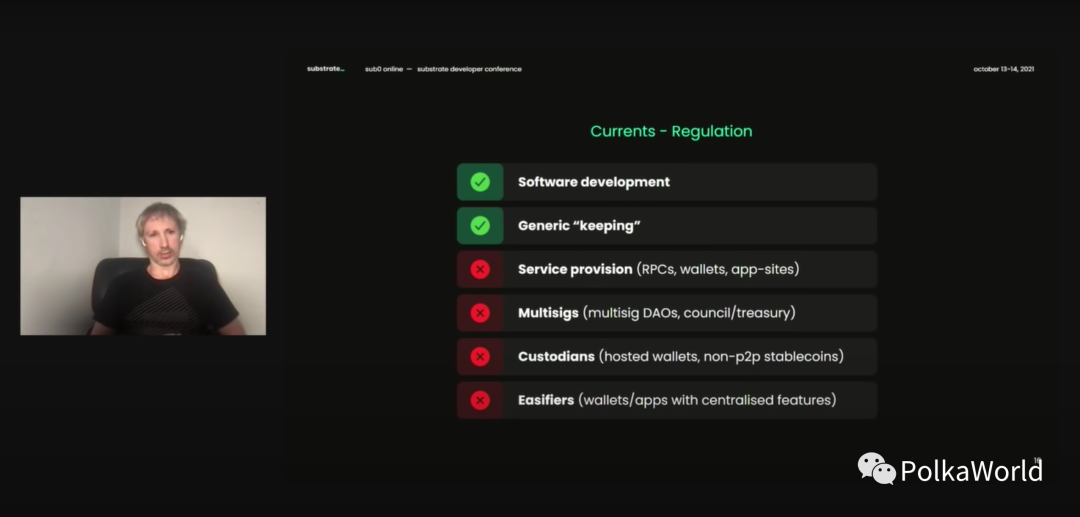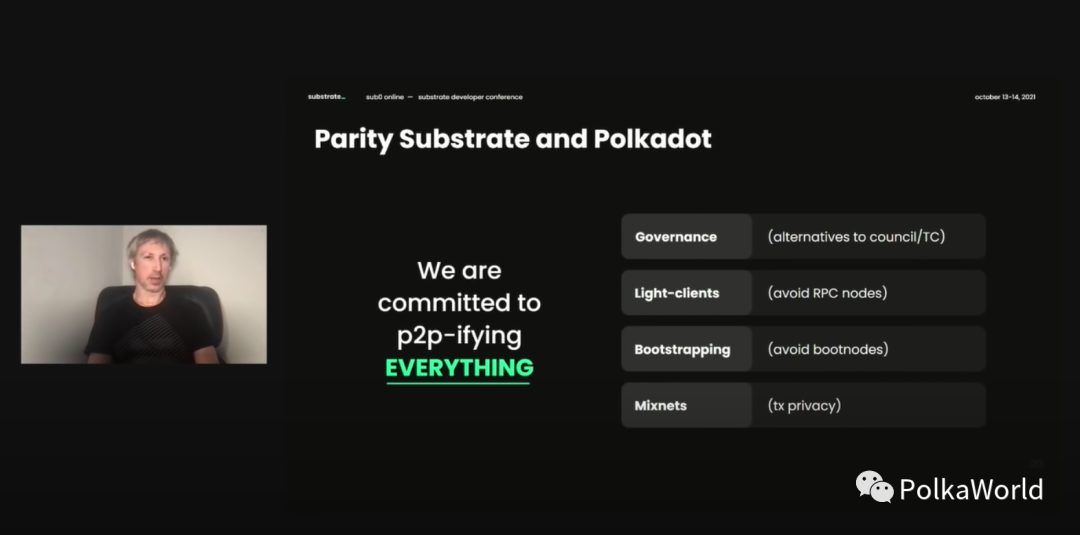Join the PolkaWorld community and build Web 3.0 together!
Join the PolkaWorld community and build Web 3.0 together!

At the Sub0 Online conference on October 13, Dr. Gavin Wood, the founder of Polkadot, gave a keynote speech, and synchronized with the developer community the development progress of functions such as parachains, the advantages of parachains and Substrate, and how Polkadot will respond to regulation, etc. . The following is an article translated and summarized by PolkaWorld based on the content of the speech.
Hi everyone, today I'm going to chat about three things quickly.
First, I will reiterate what Substrate is and the advantages of the parachain it supports.
Finally, I will talk about some of the latest industry events and their relationship with Polkadot and Substrate.
secondary title
Changes brought about by Substrate
First, let’s talk about the role of Substrate and the parachain model.

Parachains based on Substrate have the following four characteristics - uninterruptible, upgradable, unlimited, and no handling fees. I will expand on each point a little bit, so that everyone can clearly understand why we do this.
1. Cannot be interrupted
The crucial thing about Substrate-based parachains, or any Substrate-based chain, is that they are truly decentralized. In contrast, some other blockchain projects are not fully decentralized, they may be designed to be a little bit decentralized.
At Substrate, we truly pursue peer-to-peer and decentralization, which makes the chain uninterruptible. For example, the full node saves all data, and it is easy to become a validator on a Substrate chain. We have also invested a lot of effort to ensure the availability, efficiency, and high performance of light nodes. Therefore, we are trying to achieve scalability while ensuring decentralization. We will not compromise on the degree of decentralization in exchange for scalability.
2. Upgradability
The second point is scalability. While this point may be familiar to many of you, it is worth emphasizing again. It is an important slogan and core spirit of Substrate and Polkadot. The Substrate chain and Polkadot based on Substrate are both Meta Protocols. So it allows us to efficiently upgrade, update and absorb new technologies.

These two graphs can be visualized. We saw some chains like we were struggling through the mud, and we were like kitesurfing.
3. Unlimited
A big difference between the Substrate/parachain model and the smart contract model is that the Substrate chain is unlimited. I get asked this question a lot, and if you're a team that wants to be a parachain, you probably want to ask this question too, so I'll make it clear.
The Substrate/parachain model is a "free execution model", which means that you rent a certain amount of distributed CPU for a whole period of time. This model is fundamentally different from the smart contract model. The smart contract model is a transaction execution model, that is, users can pay to have your code executed for them.
As a free execution model, it will ensure that you are scheduled in the time interval, and ensure that you are scheduled at a regular interval, such as every 6 seconds for the Polkadot parachain. This model gives you a lot of freedom to decide how your application should work and implement it according to your needs. It is very important that you have the final say on which transactions are executed, not by the transaction as in the smart contract model. If for some reason you or your users can't make a transaction, it's going to be hard for your app to grow, which makes a huge difference to what your app can do.
Here is a list of the benefits that the free execution model can bring to you: on-chain scheduling, transaction prioritization, and more. To put it simply, you can easily get things like runtime upgrades, on_initialize, on_finalize, etc. that are not supported on Ethereum-style smart contract platforms in Substrate.
4. No handling fee
The last feature is that there is no handling fee. I don't mean it literally here, because obviously there are many Substrate chains that have handling fees. No handling fee here has two meanings:
You can limit user transactions to a certain amount, or within a certain range, and there is no need to introduce tokens at all. For example, you can issue certificates to users, and use an oracle to check that users have enough personal characteristics to prove that they cannot carry out DDoS attacks. There are many ways to do similar checks. This opens up the possibility of having no-stakes applications run on parachains, and this is a very interesting development because I think it will open the door to attract the masses, and currently we can only attract people who don't Mind those who have tokens, or people who already have tokens, I think this is a hindrance to going to the public.
secondary title
Technical progress report in all aspects
Next is a report on some development progress related to Substrate and Polkadot.
1. bridge
The first is the bridge, which allows the Substrate chain team to connect their own independent chains (solo chains). If for some reason, they do not want to become parallel chains, they are still in the state of independent chains. Standalone chains will have less security guarantees and slightly more latency, but gain connectivity to the relay chain. The bridge is also a very important component of some of the things we want to do next year.
2、XCM
Then the progress of the bridge is that the code audit of the bridge will be completed in about two weeks. This is actually the second audit, so it is mainly some minor adjustments. A bridge will be deployed soon, that is, the bridge from the test network Rococo to the bridge test network Wococo to test the feasibility. Before this year, we also hope to deploy a relay chain to relay chain bridge, that is, a bridge between Polkadot and Kusama, provided of course that the remaining two weeks of audit work will not find too many major problems. Parachain-to-parachain bridges are hoped to be deployed early next year.
XCM v2 has been delivered, it is part of Polkadot 0.9.11, this version contains most of the features we want to do.
Asynchronous error handler, that is, you can have on-chain code running in case some errors occur on the remote chain, and this function is implemented in a better way, all with Dispatchables and status reports, Allows the status of some XCM instructions to be reported back to other chains, since other chains may want to register the status with the code handler.
Asset capture is essentially remembering the contents of holding registers at the end of an XCM message. Many times, whether through errors or just accidents, it may be accompanied by a message that is not ready at the end of message execution, and some assets are left behind. in the holding register. This function allows these contents to be remembered and can be retrieved later.
Exeption handling, XCM's language model now has Exeption handling. Currently we are using a virtual machine model, which I think is easier to understand and expand than before. There is also version management, which allows different XCM versions to exist in a multi-chain network at the same time. The specification for v2 is also written.
"Gavin Wood: XCM Part III - Execution and Error Management"
3. Parachain

At present, the function of the parachain code has been completed, that is, all the security mechanisms in the Polkadot specification have been implemented, tested and audited. Yes, the audit has been completed and should be half way through November with regards to the revisions proposed in the audit. And we do look forward to completing the initial rollout of these features soon, adding security code to Kusama. We will allow three weeks before actually putting the code into production, but we don't think there will be any major problems with the code. Therefore, based on this, the timetable for the launch of the Polkadot parachain can be calculated.
secondary title
our opinion
Our own assessment of the status of the code is that the parachain will be technically available in December, and we can look forward to deploying it on Kusama at the end of October. So from a technical point of view, Polkadot is now ready to prepare for Lease 6 to Lease 13 Auction.
secondary title
future outlook
future outlook
Looking ahead, I would like to talk a little bit about recent events and trends in the industry, how these events will affect Substrate, and what changes you may see in the next year or so.
One thing I've noticed is that in pursuit of high transaction throughput, quite a few chains ignore the fact that decentralization and security are not optional features, although if you sacrifice network Centralization can have higher transaction throughput.
This is why it took so long for the ETH 2.0 upgrade. There are actually many reasons, one of which is that they, like us, are unwilling to sacrifice the degree of decentralization of the network. If you are unwilling to do this, then the architecture and design of the network, especially the design of security, needs to be more thoughtful. So when you see some networks claiming to be public chains with high TPS, then in many cases, these chains and some real decentralized networks are no longer comparable.
If we look at the current state of regulation, we can find some important points. I have also mentioned this in some previous reports. Although I am not an expert in this area, and certainly not a lawyer, I still talk about my views on some policy documents. If we look at FATF, it is an international entity. I remember that it is roughly equivalent to the G20 national alliance. They have issued a relatively clear policy.Check out Gavin's thoughts on regulation:、"Gavin Wood: Regulation is the driver of decentralization"

"Gavin Interview: What will the Web3.0 world look like ten years from now?" "
The good news is that software development and running and maintaining the network is beyond reproach and should be allowed to continue without regulatory restrictions because that's what we developers do for a living and it's important if people want to deploy these kinds of peer-to-peer networks One point is that such activities should be free and unrestricted.
However, it is clear that regulators around the world are taking a very hard look at some of the other activities that I feel are involved in most peer-to-peer networks and decentralized projects, some of which rely heavily on them . One is service provision, such as RPC, wallet, app website. The second category is multi-signature, like DAO, or you have a few designated people who can spend money from the DAO treasury, which also exists in Polkadot and Kusama. There is also custody, which includes managed wallets and non-peer-to-peer stablecoins. The last category I call convenient functions, such as some wallets/applications, which make decentralized applications easier to use through centralized means, but this category should be regulated later in my observation.
Service provision is the most interesting of these, because obviously peer-to-peer networks, such as Ethereum, still rely heavily on centralized RPC services, and sometimes use centralized wallets and websites to host decentralized applications. By observing the language of regulators , I think this piece should be included in the scope of supervision in the near future.
But one thing I think is certain: the more centralized you are, the greater the possibility of being targeted by regulators and sternly requiring you to obtain relevant licenses; the more peer-to-peer and decentralized you are, the more likely this is Low, so moving in a peer-to-peer direction seems like a reasonable choice.

Another feeling I got when I read these documents is that it seems that those encrypted projects that are not peer-to-peer and relatively neutral will need to obtain a license. I think this type of license may be similar to the standards of banking regulations. If this is the case, it means that most crypto projects may not continue to exist in their current form within a year or two. I think the regulation may be implemented in two to three years, but it is always good to be prepared early. Especially when the technology you need to mitigate risk is hard to come by.
At Parity, we are committed to making everything peer-to-peer, and we want to make sure that our technology is classified as not requiring regulation. This means that we have a lot of points that need to be paid attention to, especially where decentralization is not enough. For example, Boot Node and RPC nodes have centralized components, and we will make it towards light clients, class Browser client side turn. In terms of governance, we will ensure that we adopt an on-chain decentralized governance approach that will not violate any multi-signature regulatory provisions. There are also privacy mechanisms such as Mixnet.
Follow Substrate progress:
Welcome to learn Substrate:
https://substrate.dev/
Follow Substrate progress:
https://github.com/paritytech/substrate
Follow Polkadot progress:
https://github.com/paritytech/polkadot